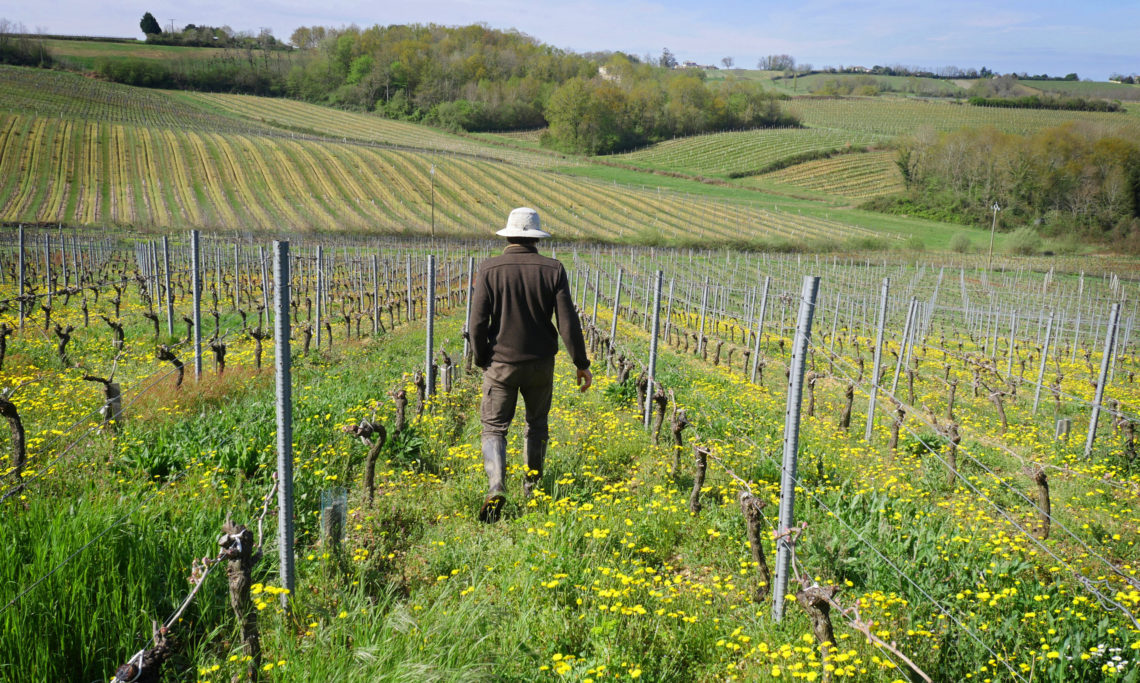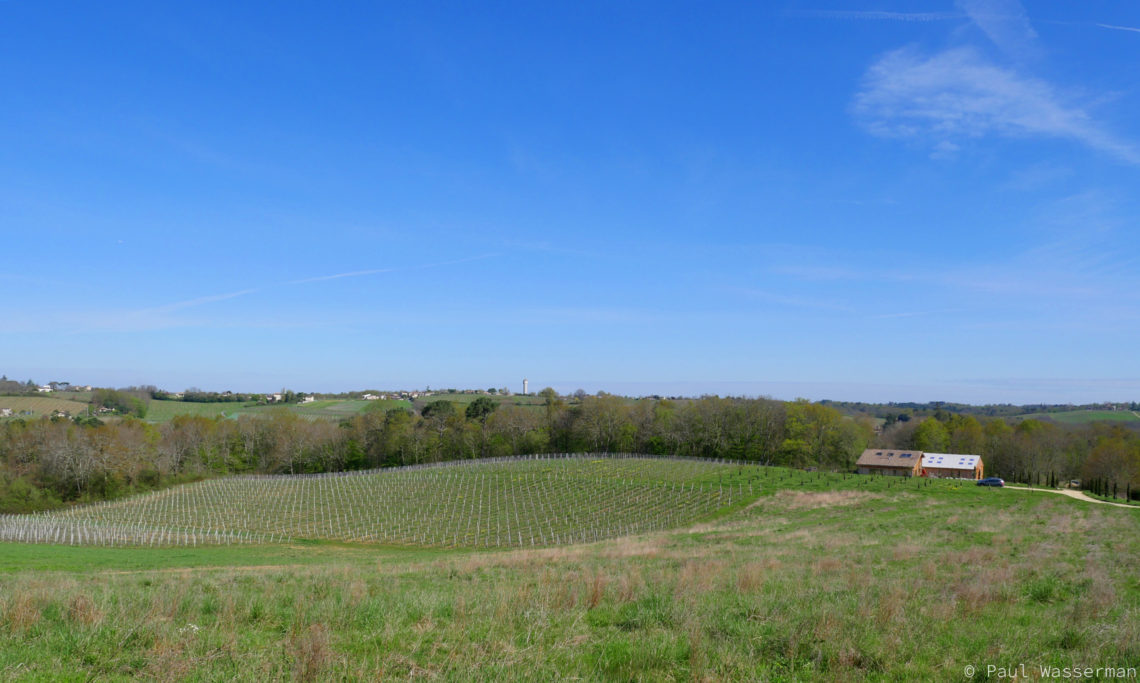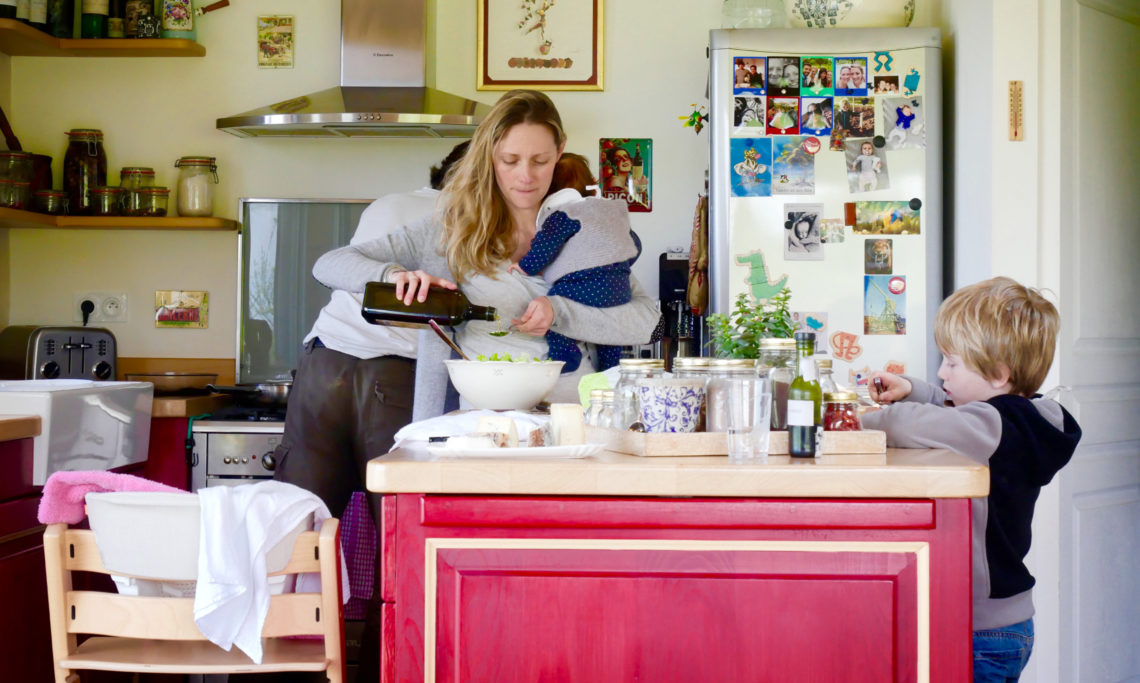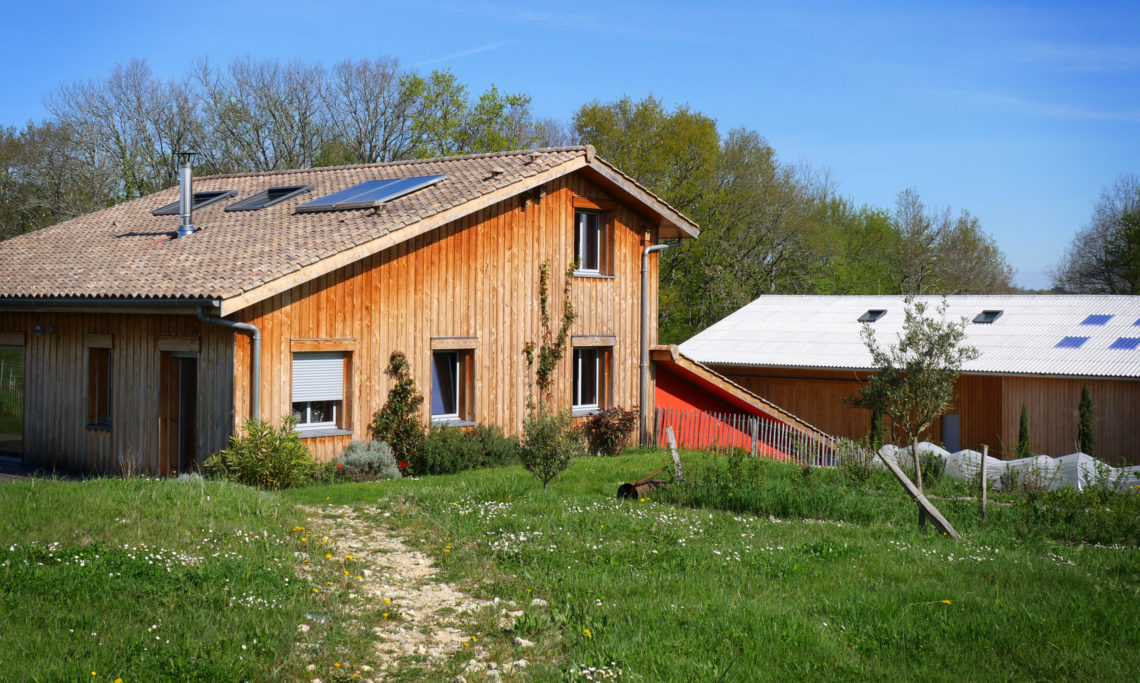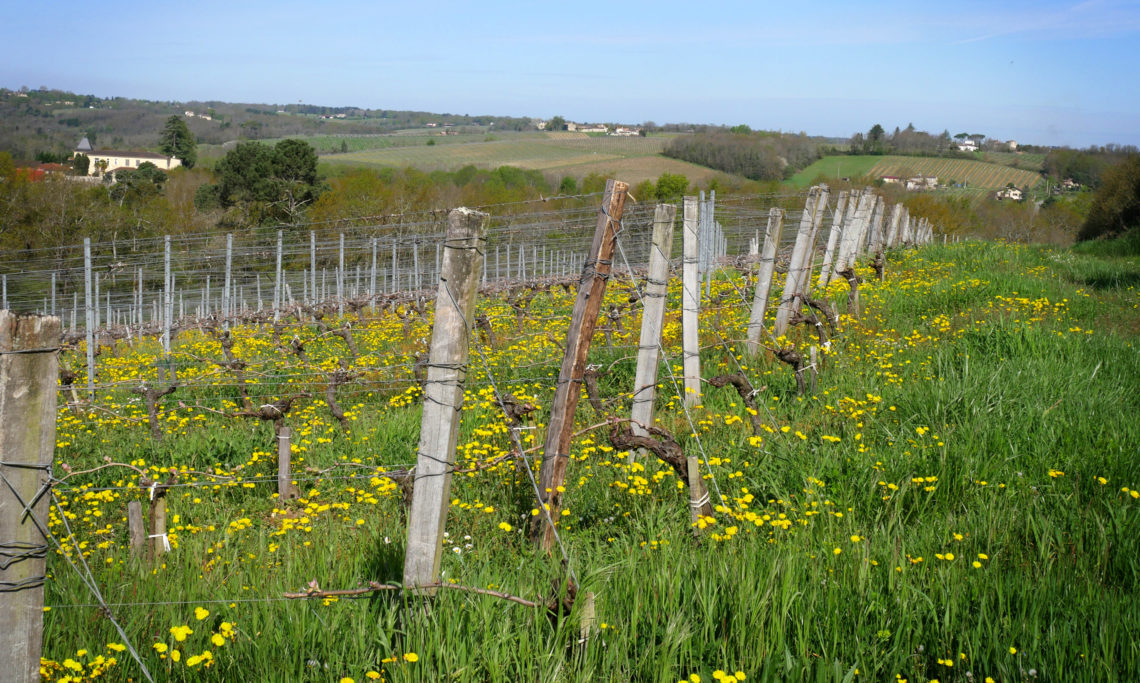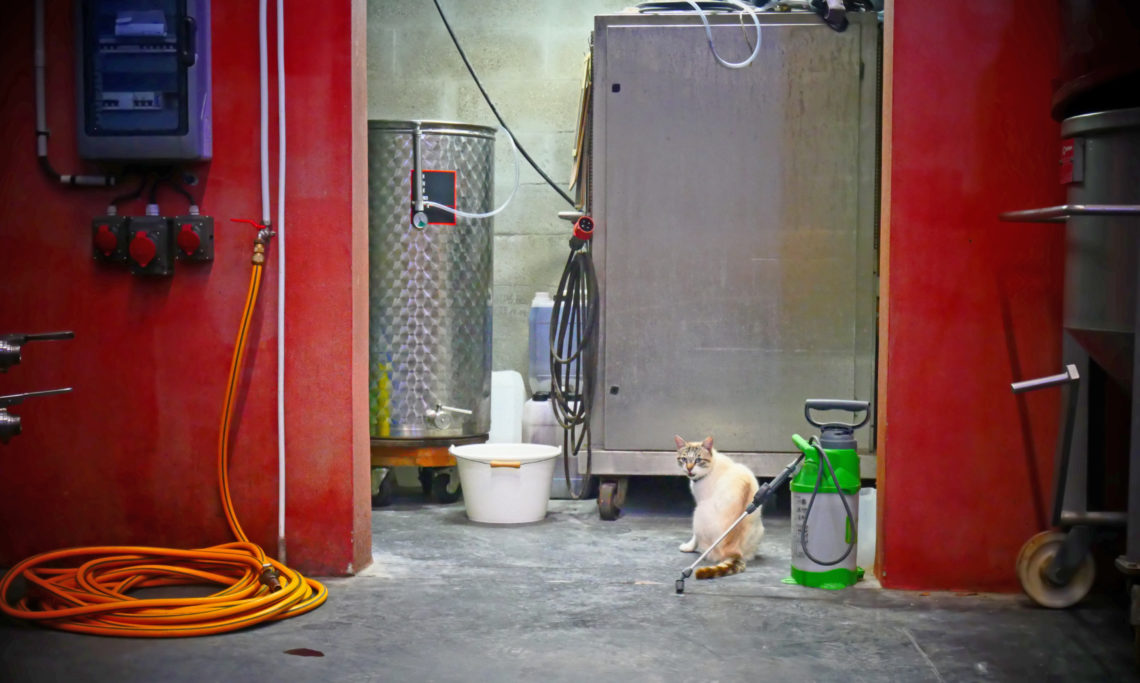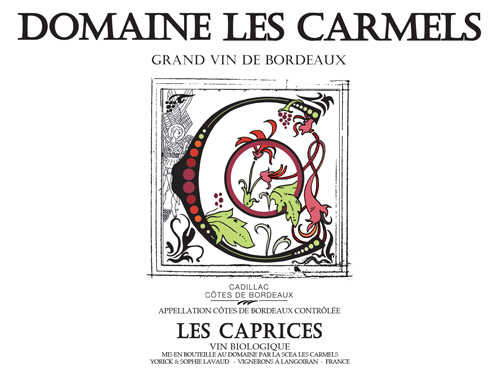Domaine Profile
- Location: Cadillac, Côtes de Bordeaux
- Size: 7.0 ha (17.29 ac)
- Variety: 66% Merlot, 17% Malbec, 11% Cabernet Franc, 6% Cabernet Sauvignon
- Viticulture: Organic (Qualisud, 2010), biodynamic methods, Bordelaise pruning, cover crops.
- Vinification: 100% destemmed but many whole grapes, uncrushed. Aged in stainless steel tanks, amphorae, sandstone jars, and barrels. Minimal SO2 added at bottling.
A Different Kind of Bordeaux
One can’t say that Bordeaux and its neighboring appellations have been at the forefront of the organic and biodynamic movements. Furthermore, for more than two decades, the region was hanging on to a recipe that may have been successful (ripe, heavily new-oaked, technological wines) but that many wine aficionados no longer find to their taste. Consequently, Bordeaux and friends are scarce on the wine lists of most of the hot new bistros, where you will find two dozen Gamays and Poulsards before you spot a Cabernet Sauvignon or Merlot, if you spot any at all. For a region that once dominated French wine sales, it is a spectacular fall from grace.
But things are definitely changing, with domaines like Les Carmels: certified organic, practicing biodynamic, affordable, and made in a softly-extracted, no new oak, very low sulfur, and beautifully quaffable style. The domaine is located in Cadillac Côtes de Bordeaux.
Cadillac?
Yes. So is there a connection, you know, to the Escalade?
Well…
The Cadillac Automobile Company was established on August 22, 1902, and named after French explorer Antoine Laumet de La Mothe, Sire de Cadillac, who had founded Detroit in 1701. The Cadillac crest is based on his coat of arms. (source: Wikipedia.)
Except that Laumet de La Mothe was no Sire of Cadillac —not a Sire, not from Cadillac, not even a de la Mothe, with no rights to a coat of arms. He was just Antoine Laumet.
Laumet was born to a respectable bourgeois family in Saint-Nicolas-de-la-Grave, near Toulouse, 100 miles southeast of Cadillac. Little is known about him until he arrived in Canada, in 1683, at the age of 25. But for him to leave France and forge a new identity in the New World, it is hypothesized that he must have done something quite naughty.
Once in Canada, he appropriated his new name, title, and part of his coat of arms from a friend of his father, a counselor at the parliament of Toulouse, and the rightful Lord Cadillac: Sylvestre d'Esparbès de Lussan de Gout, Baron de Lamothe-Bardigues, Seigneur de Cadillac, de Launay et du Moutet. The reason Laumet chose this man’s name? Rumor has it that he was enamored with Lord Cadillac’s wife.
Fake identities aside, Laumet did go on to lead an interesting life in the New World. He was an explorer, a cartographer, the father of 6 daughters and 7 sons, and engaged in the fur trade with Indian tribes —and perhaps the illegal sale or trade of alcohol to them, something that brought on numerous run-ins with the law and time in jail. However, he did found Detroit in 1701. But he misbehaved there and was sent off to Orleans as governor of Louisiana.
Cadillac, the town: There are several near Bordeaux. But we think the one referenced in Cadillac Motors is the same that gave its name to the appellation Cadillac Cotes de Bordeaux.
It is 45 minutes southeast of Bordeaux, on the right bank of the Gironde river. It was founded in 1280, has 2,700 inhabitants, and a 400-year-old psychiatric hospital. Cadillac’s chateau was in serious disrepair in the 1950s when Cadillac Motors stepped in and became the main patron for its restauration.
Domaine les Carmels
Yorick Lavaud was born on August 23, 1977 and grew up in Créon, a 10-minute drive from the domaine. There were no vineyards in his family, at least not his immediate family: his great-great grandfather owned ten chateaux in the Graves, including Fieuzal, Malartic Lagraviere, and Domaine de Chevalier. “But we’re from the impoverished branch of the family,” says Yorick. He studied agronomy in Paris, then oenology in Bordeaux, and capped it off with studies in the commerce of wine.
Sophie Lavaud was born on August 24, 1984 and grew up in Bordeaux. Her parents were both teachers, but the family was from the Dordogne, a region where food and wine are important —one of her uncles was a broker in Perigord black truffles. While studying in Montreal, Quebec, she was often told “Oh, you’re from Bordeaux. So you must know a lot about wine.” This made her realize that, in fact, she knew very little about it. Upon her return to France, she studied the commerce of wine, at the same university as Yorick. This is where the couple met in 2007.
After his studies, Yorick worked for Rothschild and was responsible for sourcing wine for them. He frequently scoured the Entre-Deux-Mers and knew the terroirs well. In 2009, he found a 17-hectare property for sale. It was only one-third planted to vines, which made it undesirable to the local large vineyard owners. And there were no buildings on it. “Basically, it went for the price of a modest house in the suburbs of Bordeaux,” Yorick says. So the young couple was able to finance the purchase and construction of their house and winery through a bank loan, complemented by European grants for young entrepreneurs.
What they built does not look bordelais at all. Standing in the vineyards a hundred yards away from the buildings, you feel you could be, say, in Oregon. This is because the domaine is somewhat isolated, the buildings are modest, near the forest, and are made for the most part out of wood. Wood wasn’t actually a premeditated choice, though, it was just economical. But it gives the domaine a pioneering, frontier feel, which is very fitting: unoaked, low-sulfur wines are still a rarity in Bordeaux.
The couple managed the vineyards organically from the beginning and follow biodynamic precepts. They were Ecocert-certified in 2010 but did not at first put the certification on the label because organic wasn’t well-received in Bordeaux. “I remember an early tasting with a wine merchant in Bordeaux,” says Sophie. “He loved the wine at first. But once I mentioned it was organic, he disparagingly said, ‘So that’s that taste.’” It was only in 2015, after numerous requests from their customers in Paris, that they finally put the certification on their label.
Organic is more than a choice of viticulture for the couple, it’s a way of life. They source organic food, of course. All the wood in the house and winery is chemical-free, and where there is paint, it is made with natural pigments. The low-sulfur winemaking is health-related as Yorick has minor issues with asthma (though the initial impetus for it was a book: Les Grands Vins Sans Sulfites, by Arnaud Immélé.)
There is also an organic, wholesome view for the rest of the property. There are currently 6 hectares of vines, 5 hectares of pastures, and 6 hectares of woods. The woods are protected: you can’t exploit them commercially, or basically do anything that would harm them. Many land-owners would be annoyed, but Sophie mentions this with a warm, maternal smile.
In one of the pastures, the couple has planted 50 varieties of fruit trees as a test. Once they know which ones work well on their site, they plan to plant an orchard. They also want to plant table grapes, resistant varieties that will not require treatment. The vision is not fully-formed, but they imagine a pick-your-own-fruit farm. We are eating in the couples’ house in their open kitchen and dining area when they tell us this; they have cooked the meal while we are talking. We mention to them the honor-system fruit stands in the US, and then crack up: it would never work in France. For we are in France, but it doesn’t feel like we are in Bordeaux.
The Appellation: Cadillac Côtes de Bordeaux
The red Côtes de Bordeaux appellations were revamped in 2009. There are now six of them: Blaye, Sainte-Foy, Francs, Castillon, and Cadillac. The last one, generic Côtes de Bordeaux, allows the blend of any of the five others.
Cadillac Côtes de Bordeaux is a sub-region of Entre-Deux-Mers. It begins almost directly east of Bordeaux and forms a 60-km long, but fairly narrow, band of vineyards that hugs the right bank of the Garonne river. (It is basically the right bank mirror appellation to the left bank’s Graves and Pessac-Leognan.) The total area under vines is 1,000 hectares. The authorized varieties are: Merlot, Cabernet Sauvignon, Cabernet Franc, Malbec.
The dry whites made in the appellation are called Premières Côtes de Bordeaux. There are currently 100 hectares planted to Sauvignon Blanc and Sémillon.
The appellation Cadillac (without Côtes de Bordeaux) is reserved for sweet wines and a smaller area around the village of Cadillac. There are currently 140 hectares planted to Sauvignon Blanc, Sémillon and Muscadelle.
Wines
-
White
-
Red

